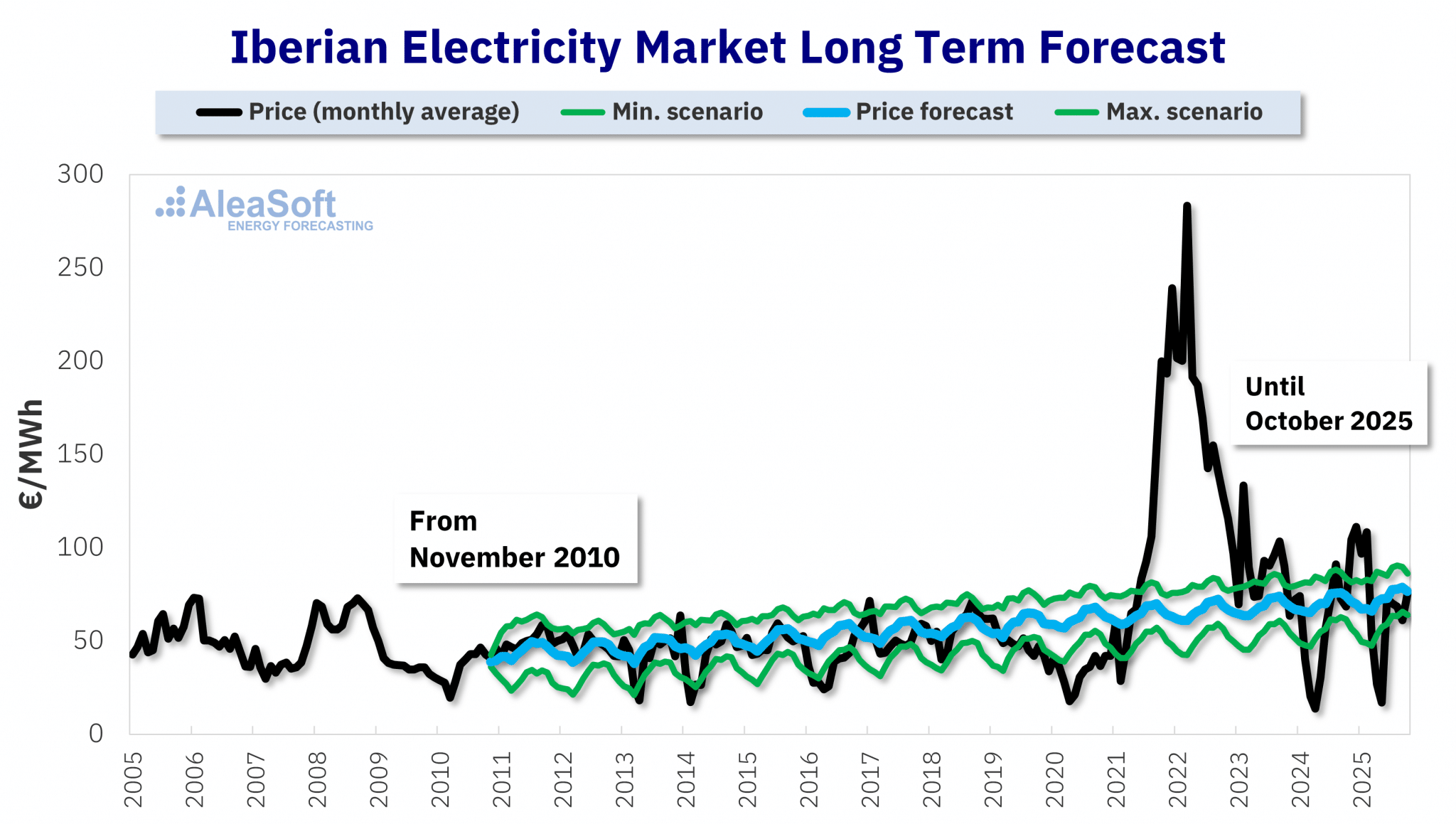AleaSoft Energy Forecasting, November 5, 2025. In October 2025, the long‑term price forecast prepared by AleaSoft Energy Forecasting in November 2010 for the Iberian electricity market reached the end of its horizon. Fifteen years later, the result confirms the reliability of the company’s methodology and its ability to anticipate the evolution of energy markets over extended timeframes. The real average market price in October 2025 was €75.75/MWh, while the price forecast in 2010 was €76.63/MWh, representing a difference of 1.2% or €0.88/MWh. The real value also fell within the range forecast by AleaSoft, between €64.00/MWh and €86.07/MWh.
A fifteen‑year forecast that confirmed the stability of market equilibrium
The forecast was produced in a context radically different from the present one. In 2010, combined cycle gas turbines accounted for a large share of electricity generation, coal was still part of the energy mix and solar photovoltaic technology was only beginning to develop. The interconnection between Spain and France was half of what it is today and the penetration of renewable energy was much lower.
Despite the profound technological, regulatory and structural changes that have taken place since then, the real prices of the Iberian market followed the central trend projected in 2010. This result shows that AleaSoft’s models correctly identified the equilibrium level towards which electricity prices tend in the long term.
A completely transformed mix
Since 2010, the structure of the Iberian electricity system has changed profoundly. In terms of generation, wind energy production across the Iberian Peninsula increased by 41% in 2024 compared to 2010, while solar photovoltaic energy generation rose by 664% over the same period. For 2025, solar photovoltaic energy is expected to reach 801% compared to 2010 levels.
Installed capacity has also grown significantly. Across the Iberian region, wind capacity in 2024 was 59% higher than in 2010, with a forecast increase of 69% for 2025. Iberian solar photovoltaic capacity grew by 900% in 2024 compared to 2010, with a forecast of 1073% for 2025.
These figures illustrate a deep structural transformation in both generation and installed capacity, based on data observed up to 2024 and projections for 2025. Despite this transformation, the forecast made in 2010 remained coherent and accurately anticipated both the average price level and the range of its variation over the horizon, ending in October 2025 with an actual price of €75.75/MWh versus a forecast of €76.63/MWh, a deviation of 1.2%, equivalent to €0.88/MWh, and within the forecast confidence interval of €64.00‑€86.07/MWh.
Market equilibrium, the foundation of the forecasting model
The accuracy of the forecast is explained by one of the fundamental principles of the Alea methodology: long‑term market equilibrium. Electricity prices tend to move around a level that ensures reasonable profitability for producers and competitiveness for consumers.
AleaSoft’s models naturally reproduce this behaviour, incorporating the variability introduced by factors such as weather conditions, gas and CO₂ prices or nuclear energy generation availability. Even in extreme situations, such as the 2022 energy crisis or the demand collapse during the COVID‑19 pandemic, prices eventually returned to the equilibrium level that the models had projected fifteen years earlier.
A methodology with a scientific foundation
The Alea methodology is based on a hybrid approach that combines statistical and econometric models with advanced artificial intelligence techniques. Among the tools used are Box‑Jenkins models, SARIMAX, multivariate regression and recurrent neural networks, which can capture complex temporal relationships and correct past deviations to improve future accuracy.
Thanks to this combination of techniques, AleaSoft has developed models that integrate the probabilistic behaviour and stochastic nature of markets, adapting to different temporal scales. This approach has allowed long‑term forecasts to remain coherent and stable even during periods of high volatility.
A success story in the history of energy forecasting
The completion of the 2010‑2025 forecast horizon represents a methodological milestone and a success story in electricity price modelling. For the energy sector, having empirically verified long‑term forecasts provides an essential tool for investment planning, asset valuation and renewable energy project financing.
This experience reaffirms the validity of AleaSoft’s scientific approach and its commitment to offering a coherent and well‑founded vision of the future for the European energy sector. Fifteen years after that forecast, the data show that market equilibrium remains a constant and that the Alea methodology continues to provide a solid foundation for strategic decision‑making.
Final question: Would the October price have been the same as forecast fifteen years ago without the COVID-19 pandemic, the war in Ukraine, the boom in photovoltaic energy, or if there were more battery storage capacity?
Source: AleaSoft Energy Forecasting.

